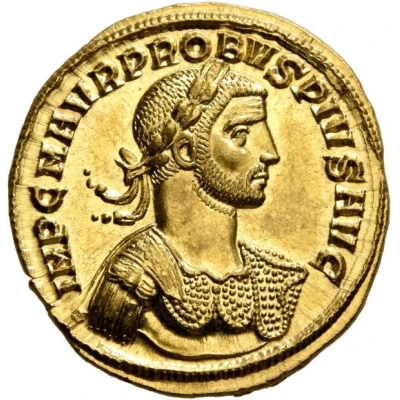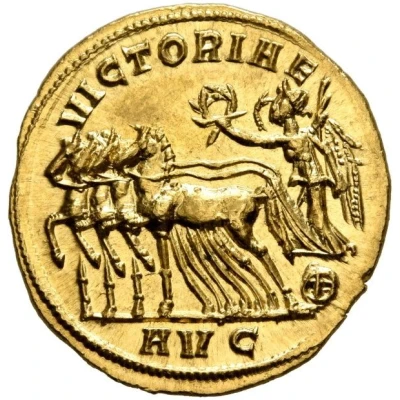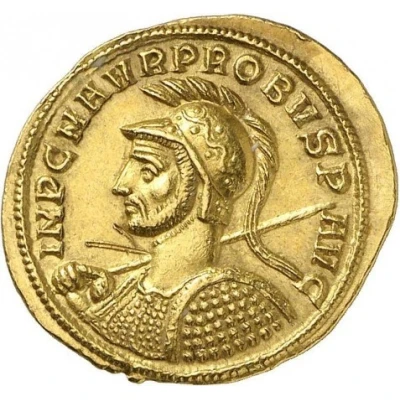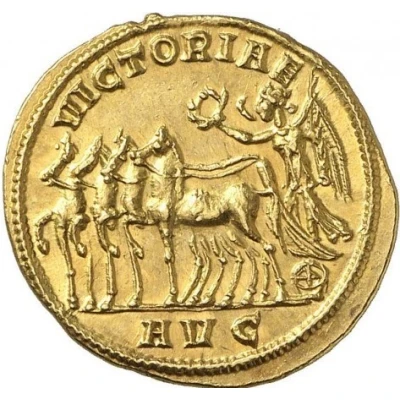


© Leu Numismatik
Aureus - Probus VICTORIAE AVG; Victory
| Gold | 6.52 g | 21 mm |
| Issuer | Rome › Roman Empire (27 BC - 395 AD) |
|---|---|
| Emperor | Probus (Marcus Aurelius Probus) (276-282) |
| Type | Standard circulation coin |
| Years | 276-282 |
| Value | Aureus (25⁄2) |
| Currency | Antoninianus, Reform of Caracalla (AD 215 – 301) |
| Composition | Gold |
| Weight | 6.52 g |
| Diameter | 21 mm |
| Shape | Round (irregular) |
| Technique | Hammered |
| Demonetized | Yes |
| Updated | 2024-10-05 |
| Numista | N#293189 |
|---|---|
| Rarity index | 100% |
Reverse
Victory, winged, draped, in slow quadriga, left.
Script: Latin
Lettering: VICTORIAE AVG
Unabridged legend: Victoriae Augusti
Translation: To the victory of the emperor (Augustus)
Comment
The years 280/1 saw a series of rebellions in Britain, Gaul, Germany and Syria that would keep Probus occupied for most of the year. Details are scanty and the succession of events is not entirely clear, but the troubles apparently started with the revolts of a certain Bonosus in Colonia Agrippina (Cologne), and of Proculus in Lugdunum (Lyon). Other reports speak of unrest in Britain as well. Probus, who had been campaigning in Asia Minor, Egypt and the East in 279-280, hastily concluded peace with the Sasanians to deal with the insurrections, and hurried west to meet the rebels, only to learn of another revolt in Syria, spearheaded by Julius Saturninus. The latter's rebellion was undoubtedly the most dangerous, for unlike Bonosus and Proculus, Saturninus was not an obscure figure, but reportedly Aurelian's former dux limitis Orientalis and Probus' own governor of Syria - clearly a highly decorated veteran. Fortunately for the emperor, Saturninus was soon assassinated, either through Probus' agents or at the hands of the usurper's own troops. With his back now secure, the emperor advanced on Gaul, where he defeated and executed Proculus, while Bonosus allegedly hung himself.Our wonderful aureus was struck in Serdica in the second half of 280 or in early 281, and commemorates Probus' victories against his various foes. The emperor's itinerary and the dating of the rebellions are not entirely clear, but the most likely background for the issue is the suppression of the Syrian revolt. If this is true, the coin was presumably struck during Probus' advance westwards to meet the rebels in Gaul and Germany. Alternatively, it may also have been issued after the emperor had crushed these revolts as well, proclaiming ultimate victory in the epic struggle for imperial rule.
Interesting fact
One interesting fact about the Aureus - Probus (VICTORIAE AVG; Victory) coin is that it features a unique blend of Roman and Greek influences in its design. The obverse side of the coin depicts the Roman empress Victoria, while the reverse side features the Greek goddess Nike (Victory) standing on the prow of a ship, symbolizing the Roman Empire's naval supremacy and military victories. This fusion of cultural influences reflects the diverse and multicultural nature of the Roman Empire during the 3rd century AD.

